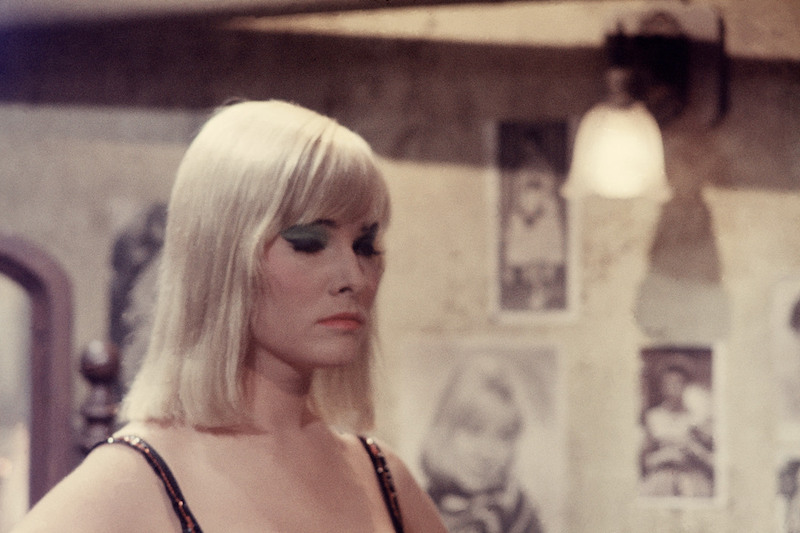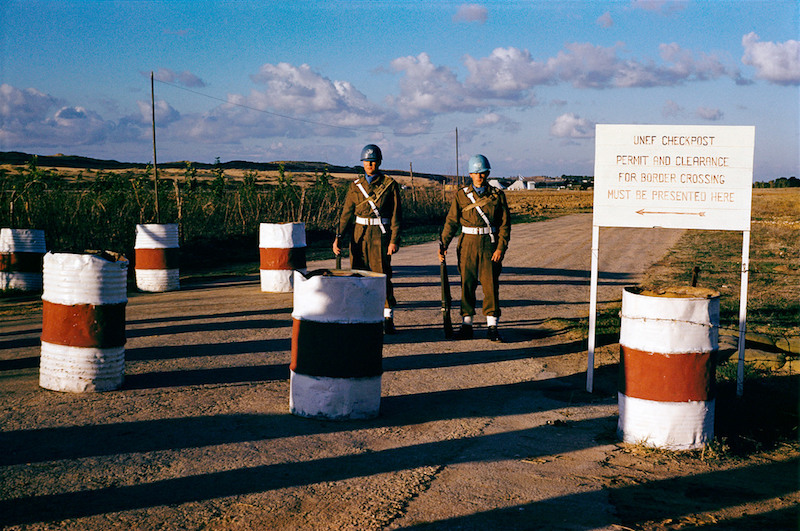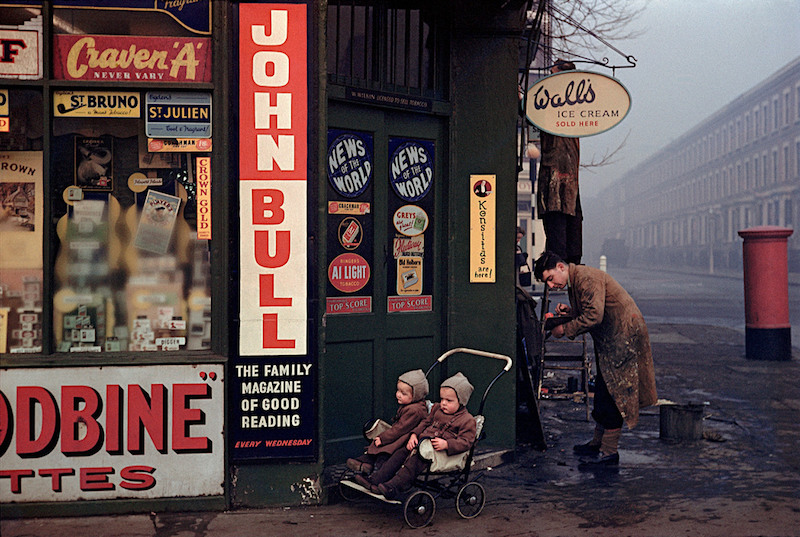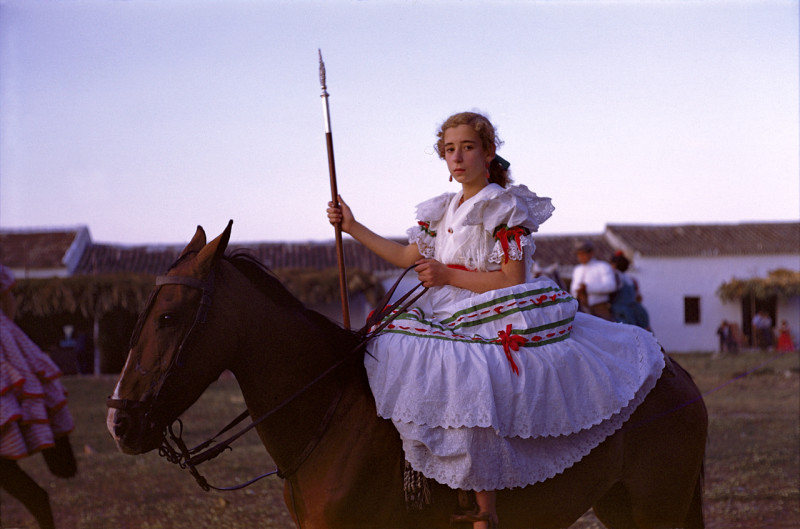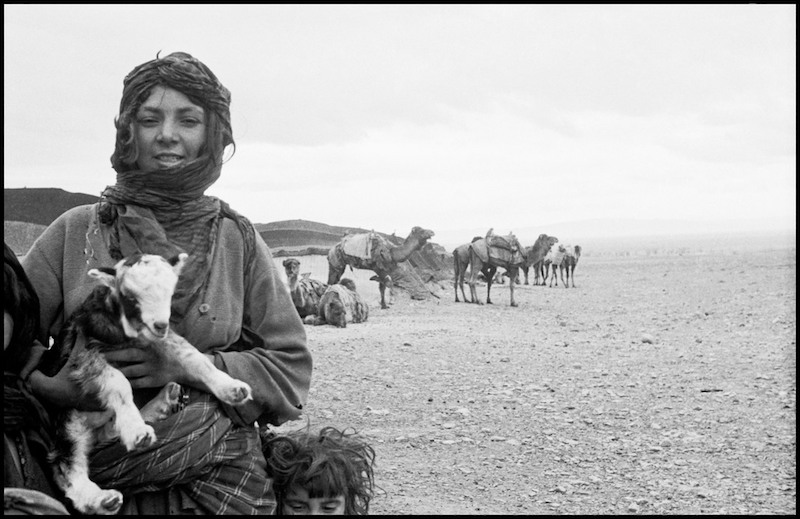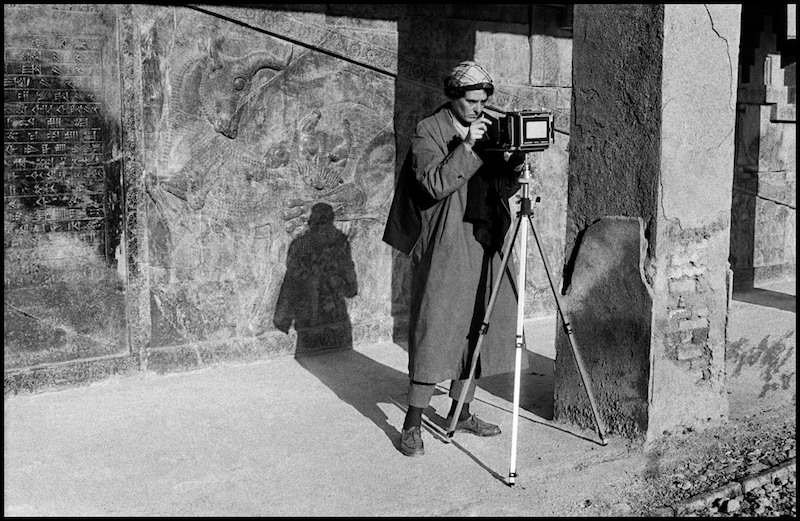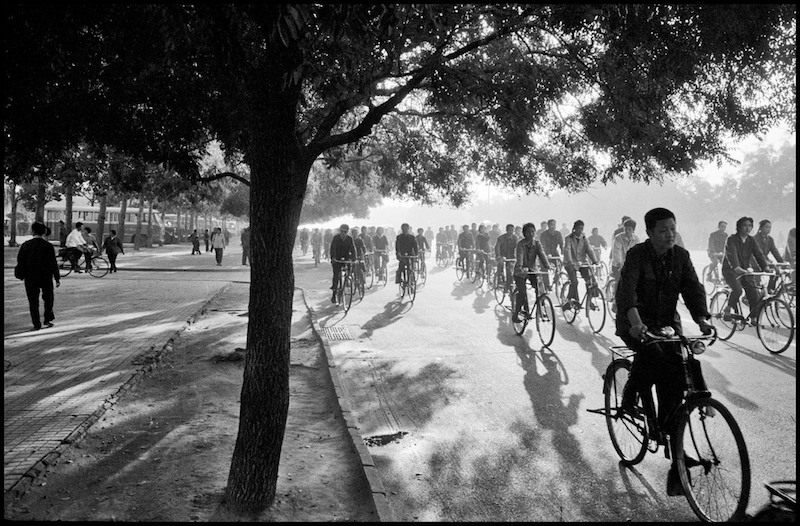The Mystery in Her Own Eyes: Extracts from a Conversation with Azar Nafisi
Interview with Azar Nafisi by John P. Jacob. From Inge Morath: Iran, Göttingen: Steidl, 2009.
Please also view the slideshow.
As an Iranian born writer on literature, who is also deeply interested in the role of women within civic society, I invited Azar Nafisi to comment on Inge Morath’s photographs of Iran from a variety of perspectives; historical as well as political, personal as well as cultural. As an writer and social critic, Nafisi shares with Morath a common set of intellectual concerns. Both are motivated by the larger historical movements of the 20th century, and both approach the study of the cultures that have been transformed by such movements through their creative output, particularly their literature and poetry. In approaching Morath’s photographs, I asked Nafisi to consider, on the one hand, how Morath might have prepared for her visit to Iran, and what impact a consciousness largely shaped by its literature might have on the photographs she made there. On the other hand, I asked her to imagine a contemporary, non-Iranian viewer of Morath’s images, whose knowledge of Nafisi’s homeland has been shaped in large part through the media coverage, much of it photographic, of recent political events in Iran. Balancing these, during our conversation, in Washington, DC on October 27th, 2008, Nafisi provided both an objective context for encountering Morath’s photographs and a sincerely personal response to them.
John Jacob [hereafter JJ]: Inge Morath came to Iran in 1956. After the war, and following the coup of 1953, the late ’50s were a period of relative stability for the country.
Azar Nafisi [hereafter AN]: 1956 was a time of stabilization in Iran. The Second World War, during which Reza Shah, the late Shah’s father, was dethroned and his son put into power, in itself created a great deal of destabilization. Then, after the coup in 1953, when the government of Prime Minister Mohammed Mosaddeq was deposed by Shah Mohammad Reza Pahlavi with support from the West, it took a bit of time to heal the wounds and create a new order. From mid ’50s, we began to have a more stable situation. That is also when the government returned more vigorously to issues of modernization; to paying attention to what Reza Shah’s vision for Iran had been.
The undercurrents of traditionalism and modernism go side by side in Iran. You see it in the situation of women, for example. To think that at the turn of the 20th century the Shah would have had numerous wives, all of whom would almost never leave the inside of the palace, and when they did they had to be covered from head to toe. Then, in Inge Morath’s pictures of Queen Soraya in 1956, we see an utterly modern woman who was half German. Now, not only would the Shah be monogamous, but he would be marrying a woman who was partly foreign and so comfortably modern. The Iranian society is thus based on a paradox. On one hand, as you see in Morath’s pictures, there are women covered from head to toe who are public; you see them in public streets. And then you see the nomads, who are covered in a very different way, a much more colorful and unconventional way. Finally, side by side with these, you see the modern women who look no different from modern western women. We lived with this paradox until the 1979 Revolution, and even now we’re living it and fighting because of it.
JJ: What would the situation have been for a Western woman entering into Iran at the time?
AN: During those days there was a constant, ongoing struggle between the religious traditionalists and the modernizers. But, at the particular moment when Inge Morath visited Iran, the modernizers were politically ascendant; it was another moment of triumph for secularization. At the same time, many resisted modernization by refusing to give up the traditional ways of life. For example, for a short period between 1936 and 1941, Reza Shah made unveiling mandatory. But many women, like my own grandmother who lived in Isfahan, refused to leave their homes, until finally he had to repeal that law.
As for Morath herself, what she, as a woman, would not have been able to do two decades before her visit to Iran, she could now be free to do. It was now possible for a single Western woman to travel around the country. The government would not make trouble for her on that score, but I think that she might have had problems traveling in Iran, because most people were not accustomed to seeing a woman looking the way she did, or to seeing an active woman.
JJ: Morath herself wore the chador while in Iran, in respect for the custom.
AN: Whether she wears the chador or not, everybody knows what’s behind it. The interesting thing for me is that, despite that, all sorts of people, most of them very traditional, were open to her taking their photographs, and they appear to be quite unselfconscious in those photographs. It is obvious that she is recording a pose, but her subjects are not posing. This is what a good photographer does: she makes the subject unaware of her presence. I think that, in a strange culture, is quite an achievement.
JJ: It’s typical of Morath’s work as a photographer that she was unobtrusive; her subjects are aware of her presence but not responding to it. Her knowledge of history and her practice of immersing herself in a culture’s art and literature before embarking on a journey gave her a unique point of entry into people’s lives.
Can you describe Iran’s intellectual culture after the war and at the time of Morath’s visit?
AN: I keep remembering my own childhood, and how everything that came from “there,” from the foreign places, became so quickly part of our lives. But at the same time, it was such a feast. So Pepsi, and then later Coke, and department stores; these all came around the late ‘50s. I was a very small child when the first department store came to Tehran. There were escalators, and in the restaurant they were serving sausages and eggs. And the joy of going there! In my book, I mention that my mother would take me to a toy store that was called Iran, but the emblem of the store was a picture of father Christmas. As I was growing up, these two things were one in my mind.
Another thing that was very much part of my life was movie houses. My father, when I was a kid, would take me to see Jerry Lewis, Norman Wisdom, Alberto Sordi. Later, Fellini and Bergman and Antonioni were our mantras. All of these were, at least in modern families, names that we talked about all the time. But films were really one of the things that many modern and non-modern families had in common. And in the ’50s, Russian movies were very popular among the young Iranians who were developing a political consciousness. So Iran’s elite were as much influenced by the West as by Marxism.
I firmly believe that the radical changes that happened in Iran have not been just political. Throughout the 20th century, and as we speak, the major transformations have been as deeply cultural as they are political. And that is why the targets have always been in culture; women and minorities, and what goes by the name of imagination.
In Iran at the time, there was a continuation of the trend to bring modernism to poetry that began at the turn of the century. But the language of classical Persian poetry has always been very resistant to modernization, so it is in literature where you see real change. From the beginning of the 20th century right through the ’40s and ’50s, and even on into the ’60s, you see an effort to transform literature from a classical – very beautiful, but classical and more formal – language, into a language of the individual rather than the ideal. There was a search for the ordinary; to find the lingo of “real people.” Persian classical poetry, apart from a few poets such as Ferdowsi and Gorgani, is dominated by mysticism, and there is a negation of reality at the center of mystical poetry because it denies the actual world. But with this new modern trend, the world started to return to literature, dealing with everyday affairs. At the same time, fiction became more earthly and sensual. This was a time of experimentation when, to accommodate the new ideas and themes, the classical rhymes and rhythms were broken.
I’ve been thinking a lot about what Inge Morath might have read before traveling to Iran. The person whom we call the father of modern Persian prose was Sadegh Hedayat, who killed himself in Paris in the 1950s. His most famous novel, a classic, is called The Blind Owl. It is timeless, like Persian miniatures and Persian poetry. It happens near the ruins of the ancient city of Rey. For the angst-ridden narrator, the present is very bleak and has nothing to offer. But the past is just as bleak; it’s a past in ruins. It doesn’t come with insights; it doesn’t come tenderly. It comes as something cruel, providing no answers, no consolations. Hedayat was much influenced by Nerval, Novalis, and Kafka, and was very popular in France, so we may speculate that Morath was familiar with his writing.
In some of Morath’s photographs I felt that there was an affinity between that feeling of being overwhelmed by a past that is so huge and a present that is evasive and inaccessible. There is a sense of pessimism about the present and its intangibility. In her photographs of the village of Taft, for example, you see these small people walking by the ruined buildings; those ruins are testaments to a marvelous past, perhaps, and to a present that has not yet been acquired. It is not yet tangible; there seems to be a fear of what it will have in store for us. Again, in a photograph of Isfahan there is a bus, and in front of it a horse and buggy. I thought it rather symbolic that the horse and buggy is blocking the bus, as if reminding us that “We’re here! We are not going to go away and you have to deal with us.” But we didn’t deal with it. We allowed the different elements of our paradox to have their own parallel worlds, side by side.
Another thing about the literature that flourished during the ’40s and ’50s – again, I’m referring to Hedayat because he played such a central role – is that modernization happened partly in opposition to Islam. Many of the modernizers searched for a Persian identity that was not Islamic. Hedayat looked to the Zoroastrian past, writing plays and stories that belonged to pre-Islamic, ancient Iran. I was really struck by Morath’s work because, in the books of photography by foreigners that I have seen, not much attention has been paid to Zoroastrians. But she focuses on them, and on the idea of these layered pasts, each of them vanquished but not vanished.
JJ: Although no documentation survives to indicate how she came into contact with the Zoroastrians, it’s clear from Morath’s notes and contact sheets that her encounters with them were of particular importance to her.
AN: And it is interesting because she doesn’t just go into the temples. She goes into homes. She is making a point about the culture of these Zoroastrian women. You can see in her pictures that although the Zoroastrian women are supposed to be dressed in Zoroastrian garb, actually they don’t really look much different from those you would call Muslim. Each has been accumulating the culture of the other. In Iran, Islam has taken much of Zoroastrian and pre-Islamic culture into its architecture and poetry. Morath attempts to bring these different layers of time into the same frame; there is Zoroastrian, there is Islamic, and then there is “modern” or secular.
Morath’s attention to the nomads is also interesting. Nomads were quite important in Iran. The beginning of their demise was much accelerated during the Pahlavi period because of the centralization of the state. The nomads were against centralization because land became more and more scarce. They had territories and they had guns, but the central government, by and by, destroyed or disarmed them. The Zoroastrians, during the Shah’s time, had more freedom. Now the government feels very threatened by them because after the Revolution there was a revival of interest in Zoroastrianism by ordinary people; a lot of people were trying to convert. Officially, because they are people of the book, they are “allowed” to exist and have their temples still. We all celebrate the New Year; the Persian New Year is Zoroastrian, the festivities you see in Morath’s photographs of Nowruz belong to that tradition, which the government could not do anything against. So, again, this book shows a past that is in ruins, but it’s not going away.
JJ: In fact, the most common response to these photographs has been to the relative absence of any symbols of modernity. I remember that you also were initially struck by the lack of urban scenes, in spite of the fact that many of the photographs were made in cities like Tehran and Isfahan.
AN: The interesting thing about modernity in Morath’s photographs is that she doesn’t choose Tehran to represent it. Photographs of modern Iran usually refer to the more obvious sites: unveiled women, or the nightclubs and the cars, but Morath does not seek those obvious symbols. It is wrong to say that she doesn’t capture modernity though, because the oil industry was what made modernism possible in Iran. Morath pays attention to that; she chooses Abadan. Now, Abadan, obviously, was so much under the influence of the British. It was a place to itself, and insulated in many ways. Morath’s pictures of Abadan are interesting because of the way she sees things differently from other foreign photographers. For example, in one picture, showing foreign employees of the refinery at a British style pub, they’re so much at home, while in another, of Iranian employees at a picnic, they’re much less so. It seems as if the Iranians are the guests.
JJ: Of course, those photographs were never published. Nevertheless, one has the sense of Morath working against the grain of her assignments.
AN: But she’s very subversive. Having been told to take pictures of Persian carpets and the blue mosques, she goes on and shows us the little girls working in the carpet factories. In one of those pictures, where three girls are sitting on top and another little one below is looking at the camera, it is amazing because the carpet becomes an extension of the girls. It is a very telling picture. There is another photograph showing the girls’ hands that is so surreal, and rather frightening. The caption explains that they’re wearing henna to protect their hands but you don’t see that; that is not its purpose. The purpose is to shock, to enlighten you as to what goes on behind this beauty: this terrible, terrible labor involving such young children.
Most books of photography on Iran bring out the lush side, the colors, the obvious beauty. There is a lot of beauty in Morath’s photographs too, but it is a really understated beauty. It is a beauty that does not want you to find its secrets. There is a defensiveness in showing the country as all lush, as if we’re afraid to see anything ugly in it. That defensiveness is not there in Morath’s pictures. Although she photographs in black and white, I almost feel that earth color that is so Persian. The same with the dust, or the peelings on the walls. And the buildings, the doors; you know the beautiful old door in her photograph of Rey that is so old that it is almost there no more. It always made me melancholy, even in childhood, whenever there was something so fine and yet dying. There is a sense of melancholy here. In these crumbling buildings and patient people, I sense certain fierceness, a resistance to life’s cruelty. Such silent resistance belongs to a culture that has lived a long, long time and is suspicious of life’s promises.
There seems to be, in Iran, an awareness of two things: the past and the transience of life. The idea about the cruelty and transience of life is very much part of a nation that is so ancient and has been, time and time again, vanquished. On one level, instability has become a part of our national character. Iran is very enigmatic, even to someone like myself who was born there. As soon as you give it one definition something completely opposite emerges. For me, the essence of Iran is evasiveness and enigma. You feel this in the way that, in some of Morath’s pictures, one element undermines the other.
In the bazaar, for example, which is the most traditional of all places, you see all these objects of modernity hanging from the ceiling, the boots and the umbrellas. Everybody is roaming around and they all seem unaware of the clash. Again, in Isfahan she photographed a little boy mending a shoe, and right by him there is the photograph of a modern man looking completely unrelated to that little boy and that dingy shop. What is the relationship? Will they start talking?
Another thing that intrigued me about Morath was the way she treated her subjects, for example in her picture of a boy with brooms. Objects become extensions of the people in her pictures, or vice versa – sometimes people become extensions of objects – and there is an affinity between them. And I love her sense of movement, the way the brooms go up and down. She is portraying a very ordinary scene and yet manages to give it a surreal feeling. She brings out something of the essence. These objects all of a sudden become like fairy tale objects. I have a favorite picture of a shoemaker. There are women’s slippers in the background and there is something about his face that I just love. What is it about this man that I find so fairy taleish? I mean, he’s just sitting there mending shoes. What is magical is the man’s complete focus on his work, one that must be quite mundane and tiresome and yet he is so wholly dedicated to it.
Another example of movement is the dance. During the Nowruz, Morath has photographed young men and girls dancing. And in Persian dance, as in Arabic, there is so much eroticism in the movements. It is obviously asking you to look. It is amazing, the curve of the body. There is so much beckoning – with the eyes, the eyebrows, the hands. Every part of the body is curving in different directions, and every part is shamelessly asking you to look.
JJ: You’ve spoken about aspects of Morath’s photographs that are familiar or true to your experience of Iran. There must be others that reveal her as an outsider trying to penetrate the culture?
AN: One thing that surprised me was her photographs of the Caspian. It is the most magical place in my mind. As a child, we spent most of our vacations in the places she photographed, in Rasht, Pahlavi, and in Chalus. The Caspian is so lush, but she goes and photographs it in winter, which can be bleak. At first I couldn’t recognize it, although we had been in Chalus when it was snowing. For me, it was a strange defamiliarization process, looking at the stranger within something very familiar. I felt a deep resonance, and yet I had to adjust my eyes. Somehow the green was so strong in my memory that I didn’t think it could be this barren. That is what she seems to see in Iran: a certain barrenness.
And her mountains are different from other photographs of mountains in Iran. Most of those pictures present the mountains as majestic, and many focus on Damavand, the highest peak and a strong symbol of Iranian nationalism. But Morath photographed the mountains of southern Tehran, which are lower. When you have a landscape that is barren, when you have a mountain that is lost in the mist, when you have a Caspian scene shrouded by fog, all of this creates a sense of an absence that is as articulate as what is present and visible. It creates an air of mystery. There is a sense of mystery to her photos, as if not just the presences, but also the absences are speaking.
Maybe that’s how she saw. It could be, and this is pure speculation, that for her this place was itself a puzzle. She was photographing the mystery in her own eyes. Most people who go to Iran fall in love with it because people seem so welcoming. There is a welcome, but that doesn’t mean that people are opening to you. It means that they are treating you as a dear guest. So I thought, maybe that is how she feels, like a guest who’s trying to peek in. There is a shroud over many of the photographs, as if to say that what is there is not being wholly revealed. And if we cannot reveal everything, let’s have the idea that this place is defined as much by what it doesn’t reveal as by what it does.
Another thing that interested me is the way that some of Morath’s characters avoid looking at one another. For example, her photograph of the chibouk smoker in Tehran. There is a close proximity between the two men in the picture, and it’s obvious that they must know one another, but they are not interacting; I seldom see her characters interacting. Again in Rey, in her picture of the grandfather and young woman by the old gate. They’re not looking at one another; they’re not communicating. As in her photograph of the bus and the horse and buggy, they are parallel. It is very amazing, people living side by side and each in a world that is closed to the other; they’re strangers.
In her photographs of Nowruz though, people are very much communal, very much together. Nowruz is an ancient celebration. It is something that Iranians can genuinely say they share no matter what religion or ethnicity they come from. This is one of the few places where she shows people letting go. Another is the Zoroastrian ceremony in Chum, where the bodies are in very close proximity to one another. And these are all the more exciting because she captures a special quality of light.
I remember my Tehran and Isfahan, where there is a special quality of light. If I wanted to catch the essence of what Iran is to me, it is droplets of light, the shadows that light constantly plays. In Iran there is a sudden light, and that sudden light against the darkness is so startling, so surreal. You have it in all different places. Sometimes the light reveals and sometimes the light actually covers. Morath doesn’t always use the light to reveal. She also uses it to reveal the mystery. And the effects of the sun are what you see also in her pictures of the Nowruz celebrations. That discovery by her is what makes the difference between getting the spirit of a place and just showing a place. I have not yet found the language in words to describe what light did with our lives, how it changed us, but in photography you can do that. So if we want to be thankful to Morath for doing something about Iran, it should be for revealing something that is the essence of the country, which is light. This light can be overwhelming, and it can be joyous. It can be hiding. It can be mute and go against its own nature. All through her photographs you have these different statements about light.
JJ: I’m interested in what you said about Morath photographing the mystery in her own eyes. Looking at her photographs of Iran chronologically, the first place she went to after Tehran was the village of Vanack. The photographs that she took there rely heavily on convention, suggesting that she wasn’t sure of herself in this encounter with the unknown. But as she moved forward, her photographs become quite unconventional. The reason is not that Iran became less mysterious to her, but rather that she allowed that mystery to become a part of the story she was telling. For me, this goes back to the question of literature. Morath is more a narrative than a purely documentary photographer, and her narrative is in some part a story about herself.
AN: I have always thought of literature as a way of communicating, of connecting with the world. You connect to your topic and you connect to the unknown reader. But it was the subversive role, that no matter what you’re talking about you’re subverting it at the same time, that I loved; the idea that when you write you destabilize yourself. I feel that Morath destabilizes herself by subverting the usual way of looking at Iran.
Another thing I appreciate, and I think it’s also subversive, is that although she has traditional photographs of, for example, women in black chadors, she doesn’t exoticize them. Which is what so many, including some Iranians, do. Her photographs are not sentimental, and sometimes they can be harsh towards the subject. I mean, first of all, literature or art is always about truth, and truth has never been comforting. We reveal the harsh side of ourselves through our art, and tenderness only comes when you’re able to do that. Morath finds a way of bringing out the harshness, but also treating it tenderly. Giving it respect; that is the most important point. That is the difference between this selection and the earlier [1958] publication of these photographs in which the essayist is telling us, “This is how Iranians are.” He uses the language of authority, but with Morath there is just her own narrative: “I was there.”
In Iran’s classical literature there is an obliqueness, an oblique way of expressing things. It is so metaphoric, everything is so much by implication, and reality is presented as an expression of another world, a different sphere. I don’t know how familiar Morath was with Iranian literature, but in some of her pictures you can see that obliqueness, that muteness which also speaks. That is a very important point because the things that endure in art are the everyday things of life. There is, behind her body of work, a celebration of life, a celebration of a boy who sells brooms. That is why her objects have movements, because those objects are a statement about a life, no matter how harsh or seemingly trivial that life is. For me, the most important thing is the extraordinariness of the ordinary. That is why the writers I love are the ones who are genuinely realistic, who celebrate just us being who we are. Morath does that. The people she photographs are just people, but they are so much entwined with what they do, whether they’re nomads or shoe makers or bazaaris in their place of work. These are the things that will endure no matter how transient life is.
What she does with objects reminds me, in a very strange way, of Rumi, who was such a playful poet. He brought very ordinary objects into mystical poetry. He talks about brooms and sugar, and then he makes the brooms do magical things. In one poem, which I am paraphrasing, he says, “My beloved gave me a broom and asked me to clean the dust off the ocean.” All of a sudden the broom, dust, and ocean are displaced and separated from their original functions, gaining a magical dimension. In the best of Morath’s pictures you find a similar quality.
JJ: I wonder if it’s possible for a contemporary audience, particularly one of non-Iranian viewers, to see that quality? Monika Faber, in her article for this book, asks whether it is possible to view these photographs at all, except through the prism of Iran’s more recent political history?
AN: Of course, the interesting thing is how what we know will affect the way that we see. For example, about many of Morath’s pictures I could say, “This is not the Iran that I know.” Many of these places have vanished. But what is more interesting than that is what these pictures, taken fifty some years ago, tell us about the present. That is the test for pictures; everything dates, but how do they date? When I read our epic poet Ferdowsi, what I am amazed by is not just what he reveals about our past, but also how in a very strange way he predicts our future. What gives these pictures value is not the fact that we see something that still exists, but that they still reveal something significant, something essential that goes beyond the boundaries of time. I think that if a work of art is not particular then it cannot be universal. Universality comes out of going deeply into the moment. You need to have that particularity of the moment, and then you move beyond it. The moments she has recorded are enduring not just because they’re showing the 1950s, but because there’s a trace of 1950s in the present. That is the magic of it. That is the magic not of Inge, but of her art.
Anything that stays, that makes you, fifty years later, want to publish it, should go beyond just the artist’s views. That is why we read Aeschylus. I want to look at Morath’s pictures because I read Aeschylus. She really experienced the deepest of all cruelties during her lifetime. People who have experienced what she did understand that everything goes beyond politics. But I think that the point should be made that this book comes out not because of the Islamic Republic, not because of WMDs, not because Bush and Obama are talking about Iran, but because we need to connect as human beings.
I guess the duty of art, if there is a duty, is to restore our humanity. If you’re an artist and you look at the world through a political lens, you in fact miss the politics. I mean that politics itself needs a space, but by reducing everything to it everything is lost. That is why people are not really political right now; they’re politicized. They’re not thinking about politics the way Plato talked about it. Iran, especially, has been so categorized and politicized. Of course, people will look at these photographs and they will see the women with the chador and say, “There you are, they’ve always been like this.” But I’m hoping that those people will also look at the Nowruz dancers and say, “But who are they? Will the real Iranians stand up?”

